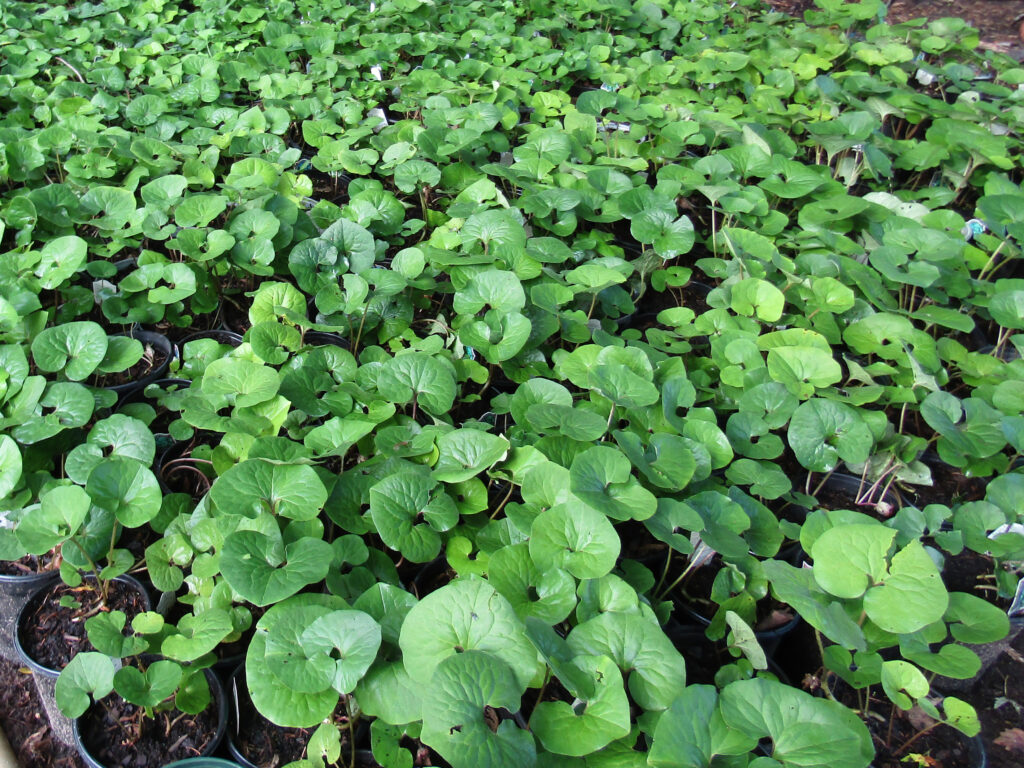
Today we want to introduce everyone to the wonders of Asarum canadense, or Wild Ginger. We have a lot of it, just now coming up, as it was over-wintered outside. It is in both a 2 ½” pot and a 4” pot that used to be 4 ½” pot and before that it was a quart. We can make this in any size pot you wish. Several years ago I thought that it was going to sell like hot cakes in that 3” 24 count tray so popular in Chicago and we sat on them until we upshifted them into gallons and it was a great success. We usually make this plant from Mid-May through June so that they get well rooted. Let us know if you will want a lot of them, we have unlimited production capability.
This Asarum has fuzzy hairy light green leaves that overlap about three different ways so the texture of a good stand of it is very much attractive. The purple flowers are right at ground level, so you will not notice them unless you are clumsy. It is herbaceous, so that it dies down to the ground in the winter, unlike the classic groundcovers such as Hedera, Vinca, and Pachysandra, all with waxy shiny dark green leaves and are evergreen all winter. Our problem with this Asarum is that by August the leaves start to get black at the edges. My plant health guy says that he cannot find a fungicide to fix the problem, that the problem is cultural, meaning that things are either too wet or too dry, but no one will tell me which one. I have no idea how these look once planted in the ground, hopefully better.
Rich people get to plant Asarum european which has really shiny dark green leaves. We would be getting closer to those rich people if we could figure out how to grow it a lot, but the European version of asarum gets this black leaf edge thing that kills it dead and to the ground if not fungicided a lot, even in a stock bed. We used to know what to spray on it but that institutional memory has disappeared.
But what I started out going to talk about today is Podophyllum peltatum, Mayapple, Indian Apple, Wild Mandrake, Pomme De Mai, and Podophylle Pelt. This is a Spring ephemeral common in the deep woods. By early July the foliage has dried up and disappeared. The roots or stolons or whatever they are are really healthy if you can find them and transplant nicely and grow all summer and the plant looks great in the spring. In fact, we are custom growing 500 gallons of this fine plant this year and can grow more in whatever size if someone tells us. If you are a trusting person, we can custom grow them for you to plant out in August. Try to not worry if they look all dead. The person in charge of production scheduling here at the nursery believes that his computer tells all the truth the whole truth and he is not into taking risks, thinking that he might get blamed for guessing wrong which sometimes happens when growing these odd plants on speculation. Let us know if you want any and we will grow a lot.
Speaking of another Spring ephemeral, I am thinking of going big time into ramp or, as some people call them, ramps, otherwise Allium tricoccum, wild leeks, which are a big event in West Virginia. They must not get many vitamins all winter in all that corn bread and salt pork up in the hills and so have to eat a lot of ramp as a spring tonic. At least it is not as bad as what I had to do every spring, which is to eat, forced to eat, Caltha palustris, marsh marigold every spring; speaking of bitter, what with all those vitamins in it and purportedly much iron.
Start to get ready to be psychologically prepared to purchase some of this ramp stuff next spring. They say this native food stuff is going to be the latest fad. We do not want to miss out on any opportunity to partake of a fad. It should be easy and fun to grow.
